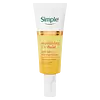What's inside
What's inside
 Key Ingredients
Key Ingredients

 Benefits
Benefits

 Concerns
Concerns

 Ingredients Side-by-side
Ingredients Side-by-side

Water
Skin ConditioningOctocrylene
UV AbsorberCaprylyl Methicone
Skin ConditioningEthylhexyl Salicylate
UV AbsorberDicaprylyl Carbonate
EmollientButyl Methoxydibenzoylmethane
UV AbsorberGlycerin
HumectantPhenylbenzimidazole Sulfonic Acid
UV AbsorberEthylhexyl Methoxycinnamate
UV AbsorberTriethanolamine
BufferingSilica
AbrasiveNiacinamide
SmoothingPhenoxyethanol
PreservativeXanthan Gum
EmulsifyingCaprylyl Glycol
EmollientCetyl Alcohol
EmollientGlyceryl Stearate
EmollientLysine Carboxymethyl Cysteinate
Skin ConditioningPEG-75 Stearate
Gluconolactone
Skin ConditioningDisodium EDTA
Steareth-20
CleansingCeteth-20
CleansingGlutathione
BHT
AntioxidantTocopherol
AntioxidantWater, Octocrylene, Caprylyl Methicone, Ethylhexyl Salicylate, Dicaprylyl Carbonate, Butyl Methoxydibenzoylmethane, Glycerin, Phenylbenzimidazole Sulfonic Acid, Ethylhexyl Methoxycinnamate, Triethanolamine, Silica, Niacinamide, Phenoxyethanol, Xanthan Gum, Caprylyl Glycol, Cetyl Alcohol, Glyceryl Stearate, Lysine Carboxymethyl Cysteinate, PEG-75 Stearate, Gluconolactone, Disodium EDTA, Steareth-20, Ceteth-20, Glutathione, BHT, Tocopherol
Water
Skin ConditioningPropanediol
SolventButylene Glycol
HumectantEthylhexyl Methoxycinnamate
UV AbsorberOctocrylene
UV AbsorberAscorbyl Glucoside
AntioxidantButyl Methoxydibenzoylmethane
UV AbsorberDiethylamino Hydroxybenzoyl Hexyl Benzoate
UV FilterTitanium Dioxide
Cosmetic ColorantCentella Asiatica Extract
CleansingAscorbic Acid
AntioxidantSodium Hyaluronate
HumectantPanthenol
Skin ConditioningPolygonum Cuspidatum Root Extract
AntioxidantAmmonium Acryloyldimethyltaurate/Vp Copolymer
Dicaprylyl Carbonate
EmollientScutellaria Baicalensis Root Extract
AstringentGlycyrrhiza Glabra Root Extract
BleachingGold
Cosmetic ColorantDisodium EDTA
Pentapeptide-4
Skin ConditioningCamellia Sinensis Leaf Extract
AntimicrobialGlutathione
Chamomilla Recutita Flower Extract
MaskingPhenoxyethanol
PreservativeEthylhexylglycerin
Skin ConditioningSorbitol
HumectantRosmarinus Officinalis Leaf Extract
AntimicrobialWater, Propanediol, Butylene Glycol, Ethylhexyl Methoxycinnamate, Octocrylene, Ascorbyl Glucoside, Butyl Methoxydibenzoylmethane, Diethylamino Hydroxybenzoyl Hexyl Benzoate, Titanium Dioxide, Centella Asiatica Extract, Ascorbic Acid, Sodium Hyaluronate, Panthenol, Polygonum Cuspidatum Root Extract, Ammonium Acryloyldimethyltaurate/Vp Copolymer, Dicaprylyl Carbonate, Scutellaria Baicalensis Root Extract, Glycyrrhiza Glabra Root Extract, Gold, Disodium EDTA, Pentapeptide-4, Camellia Sinensis Leaf Extract, Glutathione, Chamomilla Recutita Flower Extract, Phenoxyethanol, Ethylhexylglycerin, Sorbitol, Rosmarinus Officinalis Leaf Extract
 Reviews
Reviews

Ingredients Explained
These ingredients are found in both products.
Ingredients higher up in an ingredient list are typically present in a larger amount.
Also known as Avobenzone, this ingredient is a chemical sunscreen filter that provides protection in the UV-A range.
Avobenzone is globally approved and is the most commonly used UV-A filter in the world.
Studies have found that avobenzone becomes ineffective when exposed to UV light (it is not photostable; meaning that it breaks down in sunlight). Because of this, formulations that include avobenzone will usually contain stabilizers such as octocrylene.
However, some modern formulations (looking at you, EU!) are able to stabilize avobenzone by coating the molecules.
Avobenzone does not protect against the UV-B range, so it's important to check that the sunscreen you're using contains other UV filters that do!
The highest concentration of avobenzone permitted is 3% in the US, and 5% in the EU.
Learn more about Butyl MethoxydibenzoylmethaneDicaprylyl Carbonate comes from carbonic acid and caprylyl alcohol, a fatty alcohol. It is an emollient and gives skin a velvet feel. The sources of Dicaprylyl Carbonate may be synthetic or from animals.
As an emollient, Dicaprylyl Carbonate creates a film on the skin. This film traps moisture in, keeping your skin soft and hydrated.
Disodium EDTA plays a role in making products more stable by aiding other preservatives.
It is a chelating agent, meaning it neutralizes metal ions that may be found in a product.
Disodium EDTA is a salt of edetic acid and is found to be safe in cosmetic ingredients.
Learn more about Disodium EDTAEthylhexyl Methoxycinnamate is an organic compound that provides UVB protection. It often goes by the more common name of octinoxate. It is created from methoxycinnamic acid and 2-ethylhexanol.
Ethylhexyl Methoxycinnamate absorbs UVB rays with wavelengths between 280-320 nm. UV absorbers protect your skin by using chemical reactions to convert UV rays into heat and energy.
UVB (290-320 nm) rays emit more energy than UVA rays. They are capable of damaging DNA, causing sunburns and are thought to be linked to skin cancer.
The state of Hawaii has banned sunscreens containing octinoxate due to its potential impact on coral reefs. More research is needed to bridge gaps in this research. The European Union allows higher levels of octinoxate in sunscreens than the US and Australia.
Ethylhexyl Methoxycinnamate is oil soluble. It is not stable and may lose efficacy when exposed to sunlight.
Learn more about Ethylhexyl MethoxycinnamateGlutathione is an antioxidant naturally found in our bodies. It is made up of three amino acids: glycine, cysteine, and glutamic acid.
As an antioxidant, it prevents oxidative damage to parts of our cell.
While glutathione is said to help with fading dark spots, the results from research are inconclusive. Further studies are needed. With that said, gluthatione has been shown to protect our skin from UV-B induced damage.
This ingredient is naturally occurring in plants, animals, fungi, and some bacteria.
Learn more about GlutathioneOctocrylene protects skin from sun damage. It absorbs UV-B with peak absorption of 304 nm. It is a common sunscreen ingredient and often paired with avobenzone, a UVA filter. This is because octocrylene stabilizes other sunscreen ingredients by protecting them from degradation when exposed to sunlight. Octocrylene is a photostable ingredient and loses about 10% of SPF in 95 minutes.
Octocrylene also acts as an emollient, meaning it helps skin retain moisture and softens skin. It is oil-soluble and hydrophobic, enhancing water-resistant properties in a product.
Those who are using ketoprofen, a topical anti-inflammatory drug, may experience an allergic reaction when using octocrylene. It is best to speak with a healthcare professional about using sunscreens with octocrylene.
The EU allows a maximum of these concentrations:
Learn more about OctocrylenePhenoxyethanol is a preservative that has germicide, antimicrobial, and aromatic properties. Studies show that phenoxyethanol can prevent microbial growth. By itself, it has a scent that is similar to that of a rose.
It's often used in formulations along with Caprylyl Glycol to preserve the shelf life of products.
Water. It's the most common cosmetic ingredient of all. You'll usually see it at the top of ingredient lists, meaning that it makes up the largest part of the product.
So why is it so popular? Water most often acts as a solvent - this means that it helps dissolve other ingredients into the formulation.
You'll also recognize water as that liquid we all need to stay alive. If you see this, drink a glass of water. Stay hydrated!
Learn more about Water